Six Apollo spacecraft landed in six different sites on the near side of the Moon between July 1969 and December 1972, but exactly where did the Apollo astronauts touch down?
The Apollo landing sites are dotted across bright, mountainous highlands and the darker plains, or lunar maria.
During each mission a lunar module containing two men descended to the surface, leaving the third crew member to pilot the command module orbiting the Moon.
The two moonwalkers would then undertake at least one EVA (extravehicular activity), during which they would set up a TV camera, carry out scientific experiments and collect geological samples.
- Apollo Moon landing conspiracy theories crushed
- How the Apollo Moon landings changed the world forever
Each Moon landing site is geologically different and can be easily located using a telescope or binoculars from Earth.
However, it wasn’t until the Lunar Reconnaissance Orbiter launched in 2009 that we were able to make out the landers and footprints that the Apollo astronauts left behind.
Below is a guide to the astronauts’ activites, highlights of what they did there, what they brought back and what they left behind.
If you want to try and see them for yourself, read our guide on how to see all the Apollo landing sites on the Moon.

Choosing the Apollo landing sites
To select where the Apollo missions would set down on the Moon, NASA shortlisted a series of potential landing areas near the lunar equator, where the Moon’s faster rotation speed would make it easier for the ascent stages to take off.
Using high resolution images from the Surveyor probes, the smoothest, crater-free locations for each final landing site were chosen.
For the later, longer missions, more emphasis was put on choosing areas that were geologically interesting.
Apollo 11: Sea of Tranquility
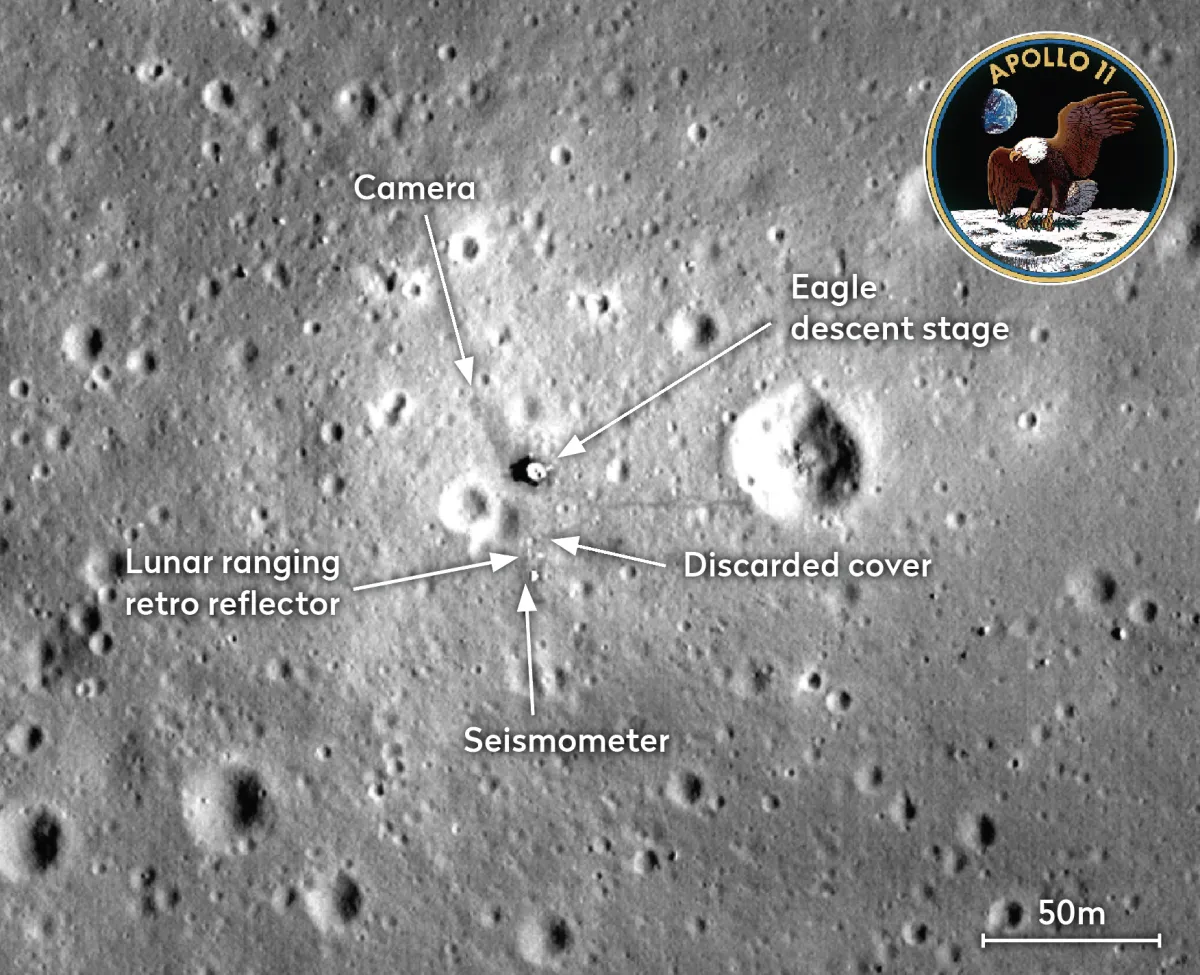
On 21 July 1969, Neil Armstrong became the first man to walk on the Moon.
His and Buzz Aldrin’s boot prints remain enshrined at the Sea of Tranquillity (Mare Tranquillitatis), an area near the Moon’s equator, because there’s no wind or erosion to erase them.
The Apollo 11 landing site is near the distinctively large crater Theophilus, to the right and southwest of the Moon’s centre.
It’s almost due north to the equator and the pin-sharp crater Moltke.
Eagle touched down northwest of Moltke beneath three smaller craters, now named Aldrin, Collins and Armstrong after Apollo 11’s crew.
Once thought to be a lunar ocean, the site is a relatively flat area with few boulders or craters.
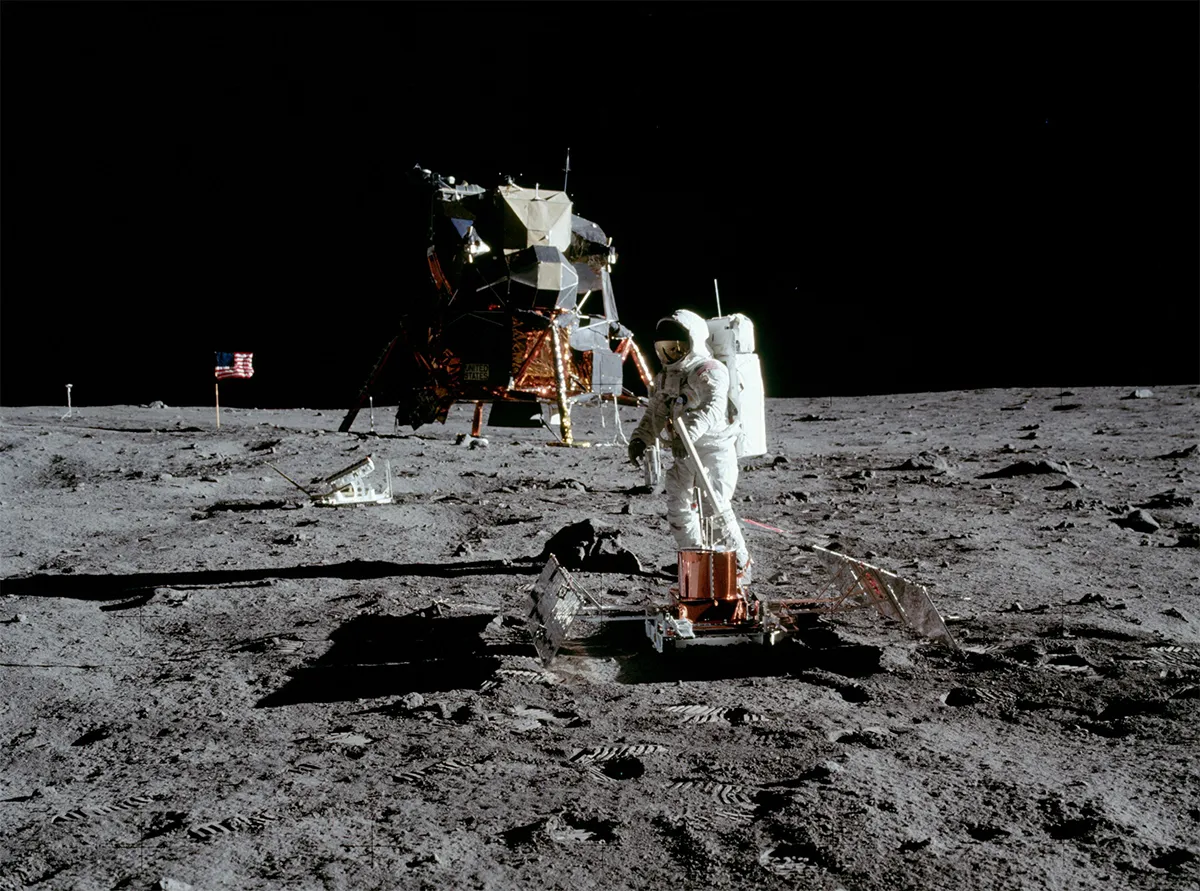
The two astronauts spent a total of two hours and 32 minutes on the surface of the Moon, travelled 1km and collected 21.55kg of samples for lunar field geology.
While they were there, they also deployed a passive seismic experiment package, a laser ranging retroreflector – to measure the distance between the Earth and the Moon – and a cosmic ray detector.
The mission left behind around 100 objects in the so-called ‘toss zone’ — from space boots and defecation collection devices to a TV camera and the American flag.
The single biggest piece of lunar litter is the descent stage of the Eagle lunar lander.
The smallest include a silicon disc containing microscopic messages from heads of state including the Queen, and an Apollo 1 mission patch in tribute to the three astronauts who died in 1967.
Apollo 12: Ocean of Storms

On 19 November 1969, Pete Conrad and Alan Bean landed on an equatorial lunar plain.
At more than 3,000km wide, the Ocean of Storms (Oceanus Procellarum) is thought to be an impact basin.
The area is southwest of Copernicus crater, the large, light grey crater within the largest dark region on the left-hand side of the Moon.
It is close to Reinhold crater and southwest of Lansberg crater. The landing site is to its southeast, almost directly below Reinhold.
The site was chosen because it contained NASA’s Surveyor III, which landed 20 April 1967, and the mission proved Apollo 12’s landing precision since it came to rest just 160m away.
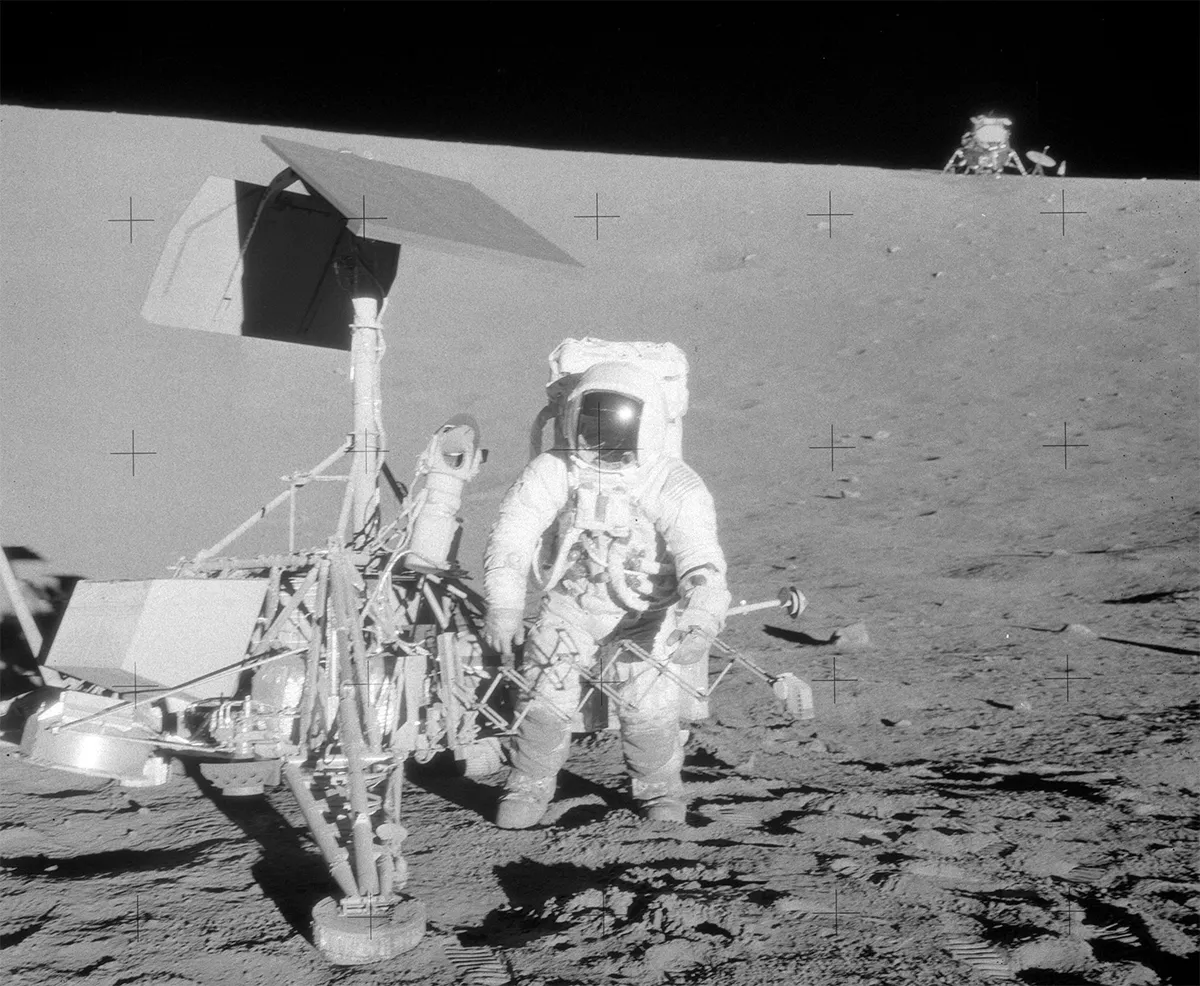
During the two EVAs undertaken by the Apollo 12 astronauts, totalling 7 hours 45 minutes, the astronauts deployed the first Apollo lunar surface experiments package (ALSEP) and also visited Surveyor III to examine its condition.
Apollo 12 returned with 34kg of lunar samples and brought back pieces of Surveyor for analysis.
Like Apollo 11, they also left behind various tools and cameras, as well as earplugs and Bean’s silver astronaut pin.
Unfortunately, during the mission, Bean accidentally pointed the television camera at the Sun while mounting it on a tripod.
This temporary loss of transmission produced a lifetime of conspiracy theories.
Apollo 14: Fra Mauro Highlands
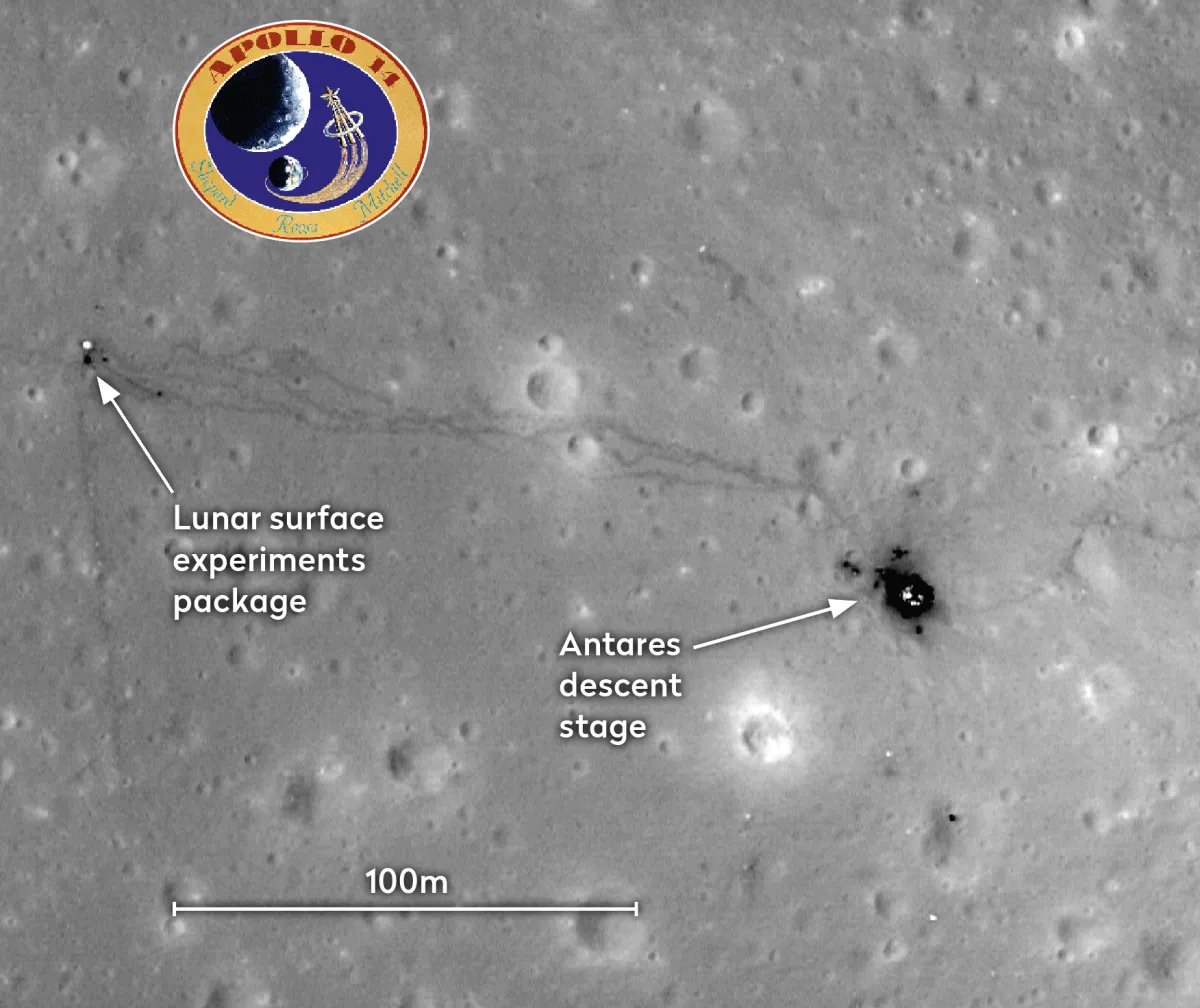
Fra Mauro is named after the 15th Century Italian monk and map maker.
Originally Apollo 13’s destination before that mission developed its famous and understated ‘problem’, it was a useful location since Apollo 12’s seismometer had detected moonquakes that originated from the Far Mauro crater.
The Apollo 14 site was also on the equator, just 177km east of where Apollo 12 landed. It lies to the right of that site and directly below Copernicus crater.
Alan Shepard and Edgar Mitchell began Apollo 14’s two EVAs on 5 February 1971.
They spent 9 hours 23 minutes on the surface, walked over 3km and collected 42kg of lunar soil and rocks.

The mission’s second EVA, to Cone crater, ended 15m from the rim, as it was on a slope and had left them 30 minutes behind schedule.
Mitchell returned with a camera, the only mission to do so, citing not enough time to remove its film.
However Commander Shepard found time for some sport before re-entering the lunar module to return home.
He attached a golf club face to a sample collector handle, hitting one ball into a crater and a second into the darkness.
So, apart from the usual detritus, Apollo 14 left two golf balls on the Moon.
Apollo 15: Apennine Mountains
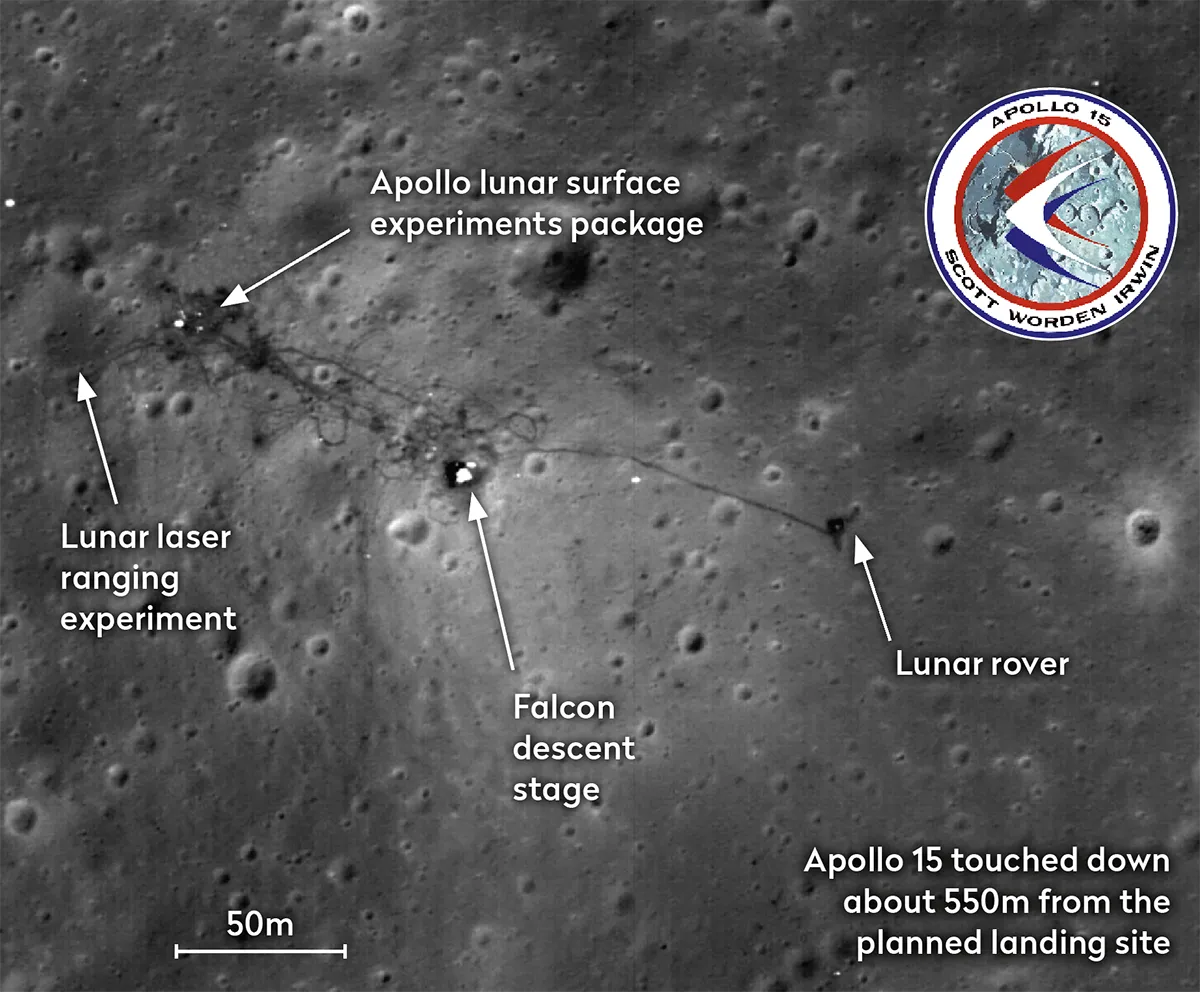
Apollo 15 was the first mission to carry a lunar rover vehicle, and the first not to set down on the equator.
It landed on the right ‘eye’ of the man in the Moon, in the Sea of Showers (Mare Imbrium), in the central part of the lunar northern hemisphere.
The site is southeast of the Archimedes crater at the foot of the Apennine mountains (Montes Apenninus).
Dave Scott and Jim Irwin took their first lunar steps on 30 July 1971. They were 550m from the planned landing point because a loose plug had required readjusting before the descent.
Their four-wheeled, electric-powered rover could reach a speed of 16km/h.This extended the astronauts’ range for exploration and capacity for samples.
As a result, they travelled 23km and gathered 370 samples weighing 77kg from both the site and the volcanic Hadley Rille nearby – a rille being the name for the narrow fissures on the lunar surface.
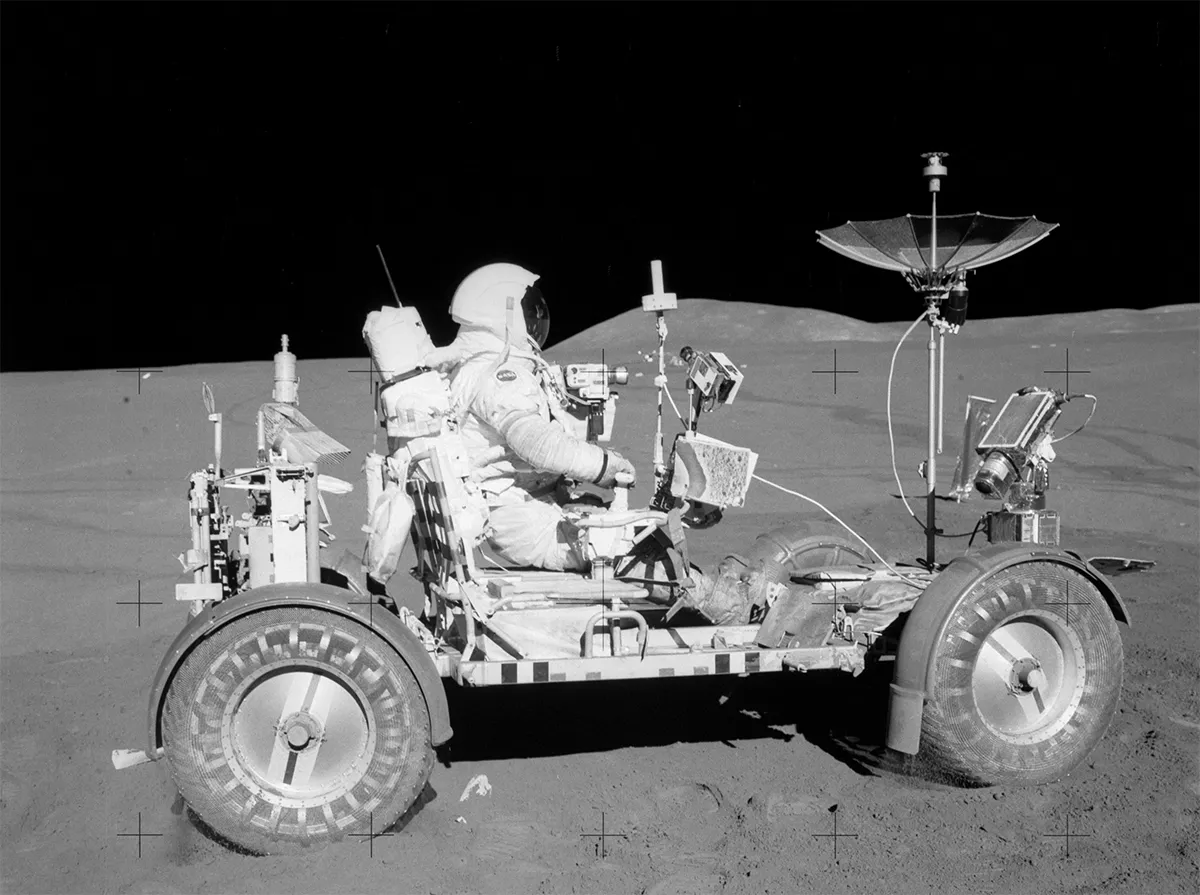
The crew were on the surface for 18 hours 35 minutes during three EVAs.
They deployed an ALSEP (Apollo Lunar Surface Experiments Package), but deploying the heat flow experiment, which required drilling a 2m hole for the sensor, proved too difficult.
One drill core, however, did penetrate to 2.4m to obtain samples.
Objects left on the Moon included a Bible, a ‘fallen astronaut’ memorial, some $20 bills, the lunar buggy, a feather and a geological hammer.
The latter two items were used to prove that objects released together in a vacuum fall at the same rate, regardless of mass – when Scott dropped the feather and hammer simultaneously, they landed on the ground at the same time.
Apollo 16: Descartes Crater
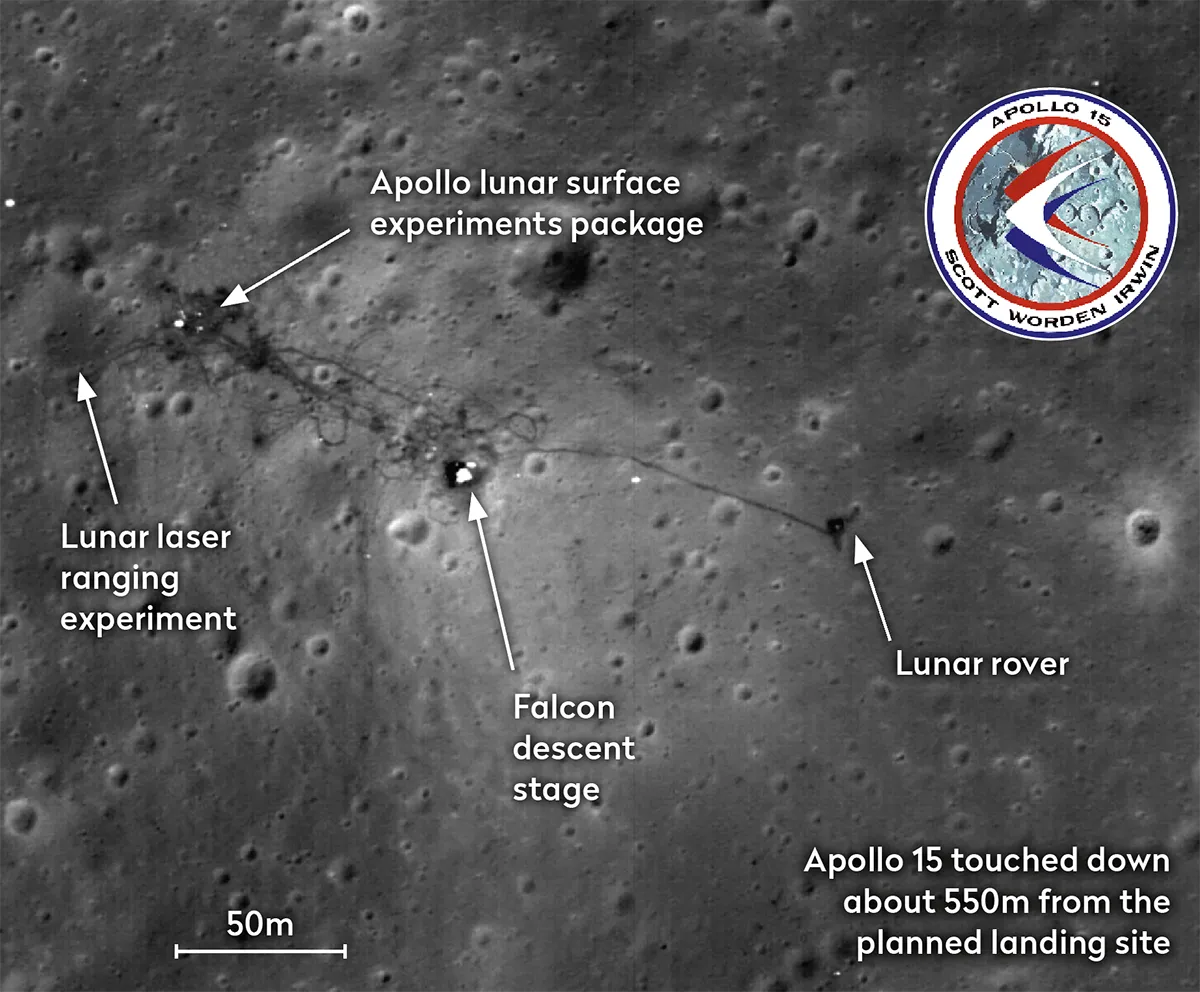
Apollo 16 was the first landing south of the equator in the central lunar highlands.
Its aim was to study the unexplored terrain of the hilly Descartes formation (named after the French philosopher) and the smooth Cayley plains.
The mission landed near Theophilus crater, due west of it, almost midway between the Theophilus and Ptolemaeus craters.
Moonwalkers John Young and Charlie Duke slept in a hammock inside the lunar module before beginning the first of three EVAs carried out across two days, on 21 April 1972.
A malfunction in an engine back-up unit had delayed the landing by several hours.

The astronauts eventually covered 27km during 20 hours 14 minutes on the surface.
Like Apollo 15, the mission carried a rover. Apollo 16 also carried an ALSEP but due to a loose cable, the heat flow experiment didn’t work.
The mission returned with 731 samples of rocks and soil weighing 96kg.
These samples revealed that the two areas were not volcanic, as had been expected, but were in fact made up of debris from impact events.
Among the usual litter of batteries, instruments and defecation bags left behind on the Moon were a hammock, a picture of Charlie Duke’s family, and a gold-plated telescope that the astronauts had used to take pictures of Earth’s outer atmosphere (the geocorona).
Apollo 17: Taurus-Littrow
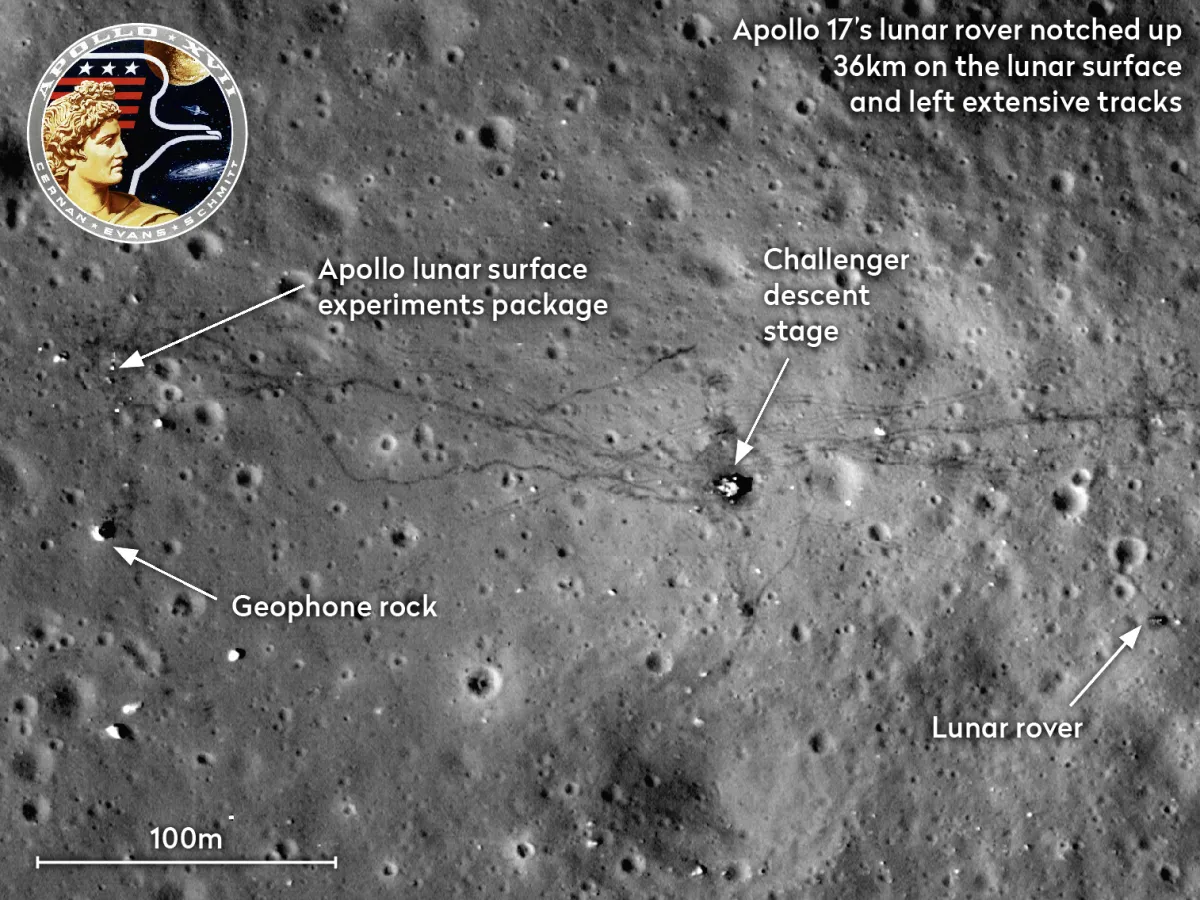
The sixth and final Apollo mission touched down in the Taurus-Littrow valley in the northern lunar hemisphere.
It was close to Apollo 15’s landing site, but further east across the dark Serenity (Mare Serenitatis) basin towards the distinctive elongated oval of Posidonius crater.
There are three smaller craters beneath it and Apollo 17’s Gene Cernan and Harrison Schmitt explored between the second and third of these, Littrow and Vitruvius.
Schmitt, a geologist, was the Apollo programme’s only scientist, and the site provided a chance to sample both young rocks from the valley floor and older rock samples from the lunar highlands.
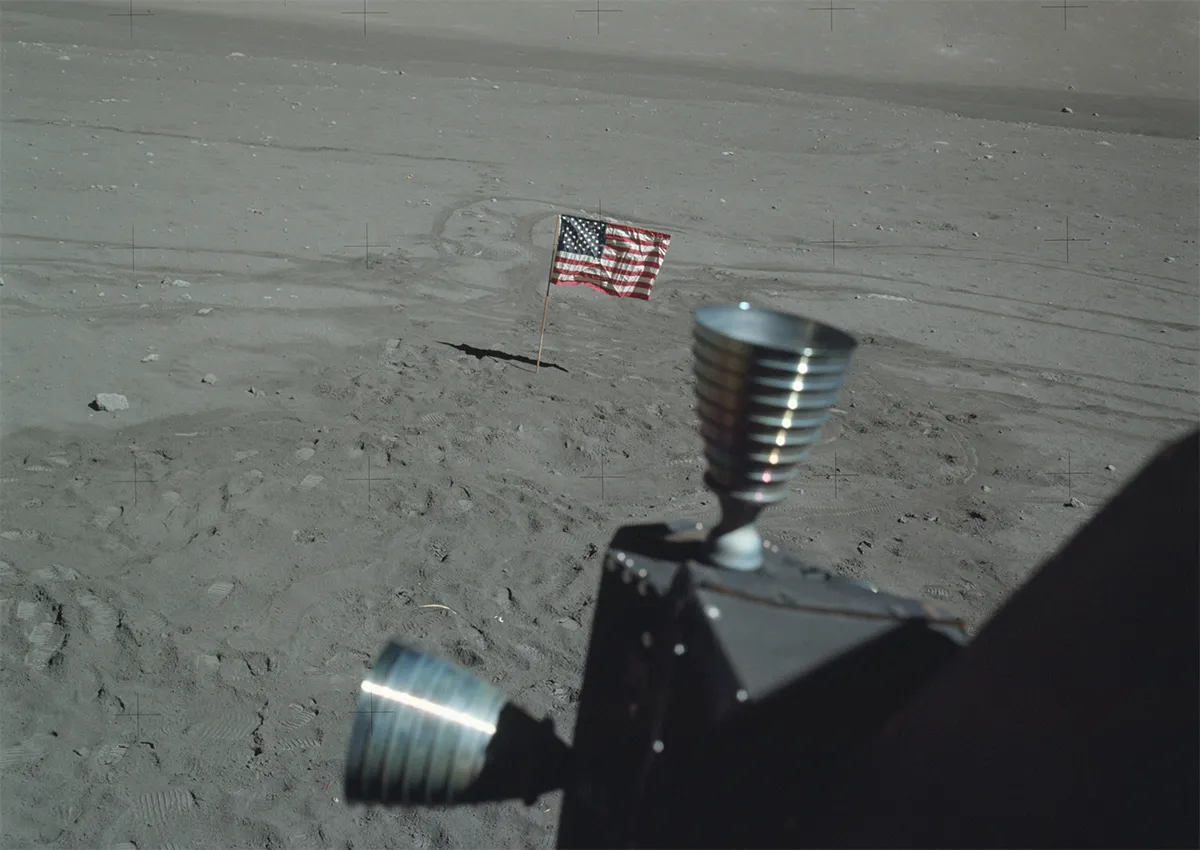
The astronauts spent 22 hours performing three EVAs with the lunar rover notching up 36km – the furthest point being 7,370m from the spacecraft.
Their 741 samples weighed 111kg and included a deep drill core that went 3m below the surface.
Apollo 17 also left behind experiments, soap and even nail clippers.
The rover was abandoned without a right rear fender because Cernan had damaged it before heading to deploy the ALSEP.
However, Cernan’s final footprint on the lunar surface, the most poignant artefact, is both ethereal and permanent.